
California Rangers Clear Illegal Marijuana Plants In National Park
Rangers cleared thousands of illegal marijuana plants from Sequoia National Park. Let’s explore how the raid protects wildlife, water, and wilderness from toxic damage.
Illegal marijuana farms are not just a police force problem; they are also a serious environmental threat. Recently, park rangers and federal agencies cleared thousands of illegal marijuana plants hidden deep inside Sequoia National Park in California. This operation not only removed the plants but also cleaned up dangerous chemicals, trash & equipment that were damaging one of America’s most famous natural treasures.
What Happened in Sequoia National Park?
In the summer of 2025, rangers and federal agents discovered a huge marijuana farm. The site spreads over 13 acres of wilderness in Sequoia National Park. Deep in the backcountry, far from roads and trails, cultivators had carved out terraces, dug irrigation channels, and hidden their crop under the old-growth trees’ canopy.
During the cleanup, authorities removed more than 2,300 mature marijuana plants along with nearly 2,000 pounds of trash, plastic irrigation pipes, and equipment left behind by growers. They also found a semi-automatic pistol and traces of dangerous insecticides. One chemical, methamidophos, has been banned in the United States since 2009 because of its extreme toxicity. Fish, birds, and animals are all at deadly risk from it, and it might even harm people who come into contact with it.
The police think the location was a part of a wider network of organized crime groups that cultivate marijuana on public lands. The investigation is still ongoing; however, rangers warn that this is not an isolated case.
How do Rangers Clear 2,300 of Illegal Marijuana Plants from Sequoia National Park?
Here’s how the rangers and federal agents carried out the massive cleanup operation.
After the discovery, Rangers and federal agents spent days carefully dismantling the site. They cut down and destroyed the marijuana plants, packed out nearly 2,000 pounds of plastic pipes, chemicals, and camp waste, and neutralized the dangerous insecticides to prevent them from spreading into the soil and waterways. They also restored damaged areas where cultivators had dug terraces and irrigation channels into the hillside. Every action focused on protecting the park’s old-growth forest and preventing further harm to wildlife.
The Long History of Illegal Grows in California’s National Parks:

This raid is just one chapter in a long story. For decades, national parks and forests in California have been hotspots for illegal marijuana cultivation. Criminal organizations see the parks as ideal locations—remote, difficult to access & rarely patrolled.
Since the early 2000s, rangers have destroyed hundreds of thousands of marijuana plants in Sequoia and other parks. As a result, the ongoing battle against illegal cultivation continues to pose challenges. Rangers have removed more than 300,000 plants, worth approximately $850 million, from Sequoia & Kings Canyon National Parks over the past 20 years.
In addition to the legalization of recreational cannabis in California, these illegal grows continue because they avoid taxes, regulations, and oversight. Many of the crops are sold on black markets outside the state, making the operations highly profitable.
The Environmental Toll:
While the plants themselves might seem harmless, the way they are grown in protected lands is devastating. Rangers and scientists point to four main types of damage:
1. Water Diversion:
Each marijuana plant consumes up to eight gallons of water daily, draining millions of gallons from rivers and creeks during California’s drought seasons. This water usage threatens fish, wildlife & even downstream communities.
2. Chemical Pollution:
Fertilizers, insecticides & toxic pesticides leak into the ground and waterways—chemicals such as methamidophos poison fish, birds, deer, and bears in addition to killing insects. Long after the farms are gone, some toxins continue to spread throughout the ecosystem for years.
3. Habitat Destruction:
Cultivators clear the forest land and cut down trees to build these farms. They dig terraces and create makeshift camps. Wildlife habitats are destroyed, trails are damaged, and fragile soil is left exposed. The scars take decades to heal, leaving a permanent mark on Sequoia’s wilderness.
4. Public Safety Risks:
Illegal grow sites aren’t just harmful to the environment—they’re also dangerous for people. Rangers have found camps with weapons, booby traps, and toxic waste scattered around the park. Hikers or campers who unknowingly wander into these areas face real threats to their safety.
The Role of Organized Crime in Illegal Grow Sites:
Illegal marijuana farms in Sequoia are rarely the work of small-time growers. Investigators believe that organized crime groups control many of these operations, using public lands to avoid taxes, regulations, and law enforcement oversight. These groups make millions by selling cannabis on black markets across the U.S., leaving behind toxic chemicals and destroyed habitats.
This type of illegal activity is part of a larger, long-term issue. NPS officials noted that organized drug-trafficking operations have been damaging Sequoia & Kings Canyon National Parks for almost two decades. Over the past 20 years, law enforcement has removed nearly 300,000 marijuana plants from these parks, worth hundreds of millions of dollars on the black market.
Officials warn that these networks are highly adaptive, shifting grow sites each season to stay hidden from patrols. As long as the profits remain high, organized groups are likely to continue targeting remote national parks. That’s why rangers stress the need for stronger enforcement, more resources, and public cooperation to fight back.
How do Rangers Remove the Farms?
Clearing an illegal marijuana farm is no simple task. To find the sites, rangers often have to walk for miles through challenging terrain. Once found, the plants are cut down and removed. At the same time, irrigation pipes & trash are packed out by hand or helicopter.
Dangerous chemicals, such as pesticides, require special handling. Crews wear protective gear and may need to dig up and treat contaminated soil to prevent exposure. Cleaning up a single site can take weeks or even months, depending on its size.
The land takes time to recover, even after removal. Park restoration teams return often to fill holes, plant native vegetation, and repair damage caused by cultivation.
What’s Being Done to Stop It?
The National Park Service, U.S. Forest Service, and other federal agencies are working together to monitor and remove grow sites. They use helicopter surveys, satellite imagery, and hiker suggestions to locate hidden farms.
The government has also appealed to the public for help in recent years. Visitors are asked to report any suspicious activity they observe. Like secret camps, black irrigation pipes, or odd clearings. The NPS Line (888-653-0009) is a secure way to report information that could lead to arrests.
In addition to progress, officials admit the problem remains unsolved. Every growing season, criminal groups adapt and shift their operations, creating new challenges. Rangers say ongoing enforcement, public awareness, and restoration work will be necessary to really protect the parks. Visitors also play a vital role in these cases. Stay alert and report suspicious activities. They can help protect these natural areas. Parks stay safe and healthy for future generations by supporting funding for rangers and restoration efforts.
The recent operation in Sequoia National Park highlights the risk and importance of preserving America’s wilderness. Rangers stopped the spread of toxic pesticides into the environment, stopped millions of gallons of stolen water, & pulled thousands of illegal marijuana plants.
More than just a crime, illegal marijuana cultivation poses a direct risk to the well-being of wildlife, national parks, and even tourists. Rangers will have the challenging task of responding as long as criminals target public lands. However, with community support and strict monitoring, these hidden natural treasures can be preserved for future generations.
FAQ’s
Q1. Why did California rangers clear illegal marijuana plants in the national park?
Ans. California rangers removed illegal marijuana plants to protect the park’s ecosystem, prevent water theft, and stop harmful chemicals from polluting wildlife habitats.
Q2. Is marijuana cultivation legal in California?
Ans. Although marijuana cultivation is legal in California with proper licenses and regulations, growing it in protected lands like national parks is illegal.
Q3. How can visitors help protect national parks from illegal activities?
Ans. Visitors can report suspicious activities to park authorities, follow park rules, and raise awareness about the dangers of illegal cultivation.
Q4. Is there a marijuana farm in Sequoia National Park?
Ans. Yes. Rangers discovered and removed an illegal marijuana cultivation site with over 2,300 mature plants spread across about 13 acres.
Read more related article > https://www.climatechallange.com/how-to-protect-your-garden-from-wildfire-smoke/